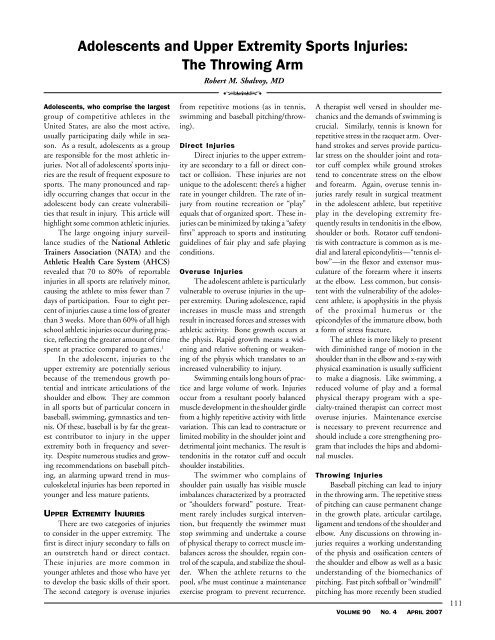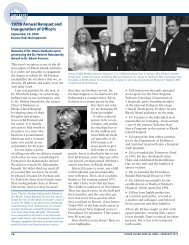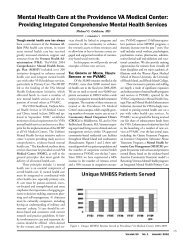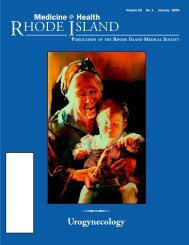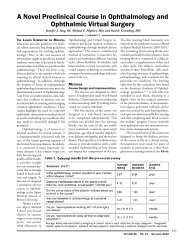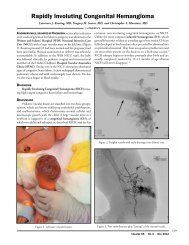April 2007 - Division of Biology and Medicine - Brown University
April 2007 - Division of Biology and Medicine - Brown University
April 2007 - Division of Biology and Medicine - Brown University
You also want an ePaper? Increase the reach of your titles
YUMPU automatically turns print PDFs into web optimized ePapers that Google loves.
Adolescents <strong>and</strong> Upper Extremity Sports Injuries:<br />
The Throwing Arm<br />
Adolescents, who comprise the largest<br />
group <strong>of</strong> competitive athletes in the<br />
United States, are also the most active,<br />
usually participating daily while in season.<br />
As a result, adolescents as a group<br />
are responsible for the most athletic injuries.<br />
Not all <strong>of</strong> adolescents’ sports injuries<br />
are the result <strong>of</strong> frequent exposure to<br />
sports. The many pronounced <strong>and</strong> rapidly<br />
occurring changes that occur in the<br />
adolescent body can create vulnerabilities<br />
that result in injury. This article will<br />
highlight some common athletic injuries.<br />
The large ongoing injury surveillance<br />
studies <strong>of</strong> the National Athletic<br />
Trainers Association (NATA) <strong>and</strong> the<br />
Athletic Health Care System (AHCS)<br />
revealed that 70 to 80% <strong>of</strong> reportable<br />
injuries in all sports are relatively minor,<br />
causing the athlete to miss fewer than 7<br />
days <strong>of</strong> participation. Four to eight percent<br />
<strong>of</strong> injuries cause a time loss <strong>of</strong> greater<br />
than 3 weeks. More than 60% <strong>of</strong> all high<br />
school athletic injuries occur during practice,<br />
reflecting the greater amount <strong>of</strong> time<br />
spent at practice compared to games. 1<br />
In the adolescent, injuries to the<br />
upper extremity are potentially serious<br />
because <strong>of</strong> the tremendous growth potential<br />
<strong>and</strong> intricate articulations <strong>of</strong> the<br />
shoulder <strong>and</strong> elbow. They are common<br />
in all sports but <strong>of</strong> particular concern in<br />
baseball, swimming, gymnastics <strong>and</strong> tennis.<br />
Of these, baseball is by far the greatest<br />
contributor to injury in the upper<br />
extremity both in frequency <strong>and</strong> severity.<br />
Despite numerous studies <strong>and</strong> growing<br />
recommendations on baseball pitching,<br />
an alarming upward trend in musculoskeletal<br />
injuries has been reported in<br />
younger <strong>and</strong> less mature patients.<br />
UPPER EXTREMITY INJURIES<br />
There are two categories <strong>of</strong> injuries<br />
to consider in the upper extremity. The<br />
first is direct injury secondary to falls on<br />
an outstretch h<strong>and</strong> or direct contact.<br />
These injuries are more common in<br />
younger athletes <strong>and</strong> those who have yet<br />
to develop the basic skills <strong>of</strong> their sport.<br />
The second category is overuse injuries<br />
<br />
Robert M. Shalvoy, MD<br />
from repetitive motions (as in tennis,<br />
swimming <strong>and</strong> baseball pitching/throwing).<br />
Direct Injuries<br />
Direct injuries to the upper extremity<br />
are secondary to a fall or direct contact<br />
or collision. These injuries are not<br />
unique to the adolescent: there’s a higher<br />
rate in younger children. The rate <strong>of</strong> injury<br />
from routine recreation or “play”<br />
equals that <strong>of</strong> organized sport. These injuries<br />
can be minimized by taking a “safety<br />
first” approach to sports <strong>and</strong> instituting<br />
guidelines <strong>of</strong> fair play <strong>and</strong> safe playing<br />
conditions.<br />
Overuse Injuries<br />
The adolescent athlete is particularly<br />
vulnerable to overuse injuries in the upper<br />
extremity. During adolescence, rapid<br />
increases in muscle mass <strong>and</strong> strength<br />
result in increased forces <strong>and</strong> stresses with<br />
athletic activity. Bone growth occurs at<br />
the physis. Rapid growth means a widening<br />
<strong>and</strong> relative s<strong>of</strong>tening or weakening<br />
<strong>of</strong> the physis which translates to an<br />
increased vulnerability to injury.<br />
Swimming entails long hours <strong>of</strong> practice<br />
<strong>and</strong> large volume <strong>of</strong> work. Injuries<br />
occur from a resultant poorly balanced<br />
muscle development in the shoulder girdle<br />
from a highly repetitive activity with little<br />
variation. This can lead to contracture or<br />
limited mobility in the shoulder joint <strong>and</strong><br />
detrimental joint mechanics. The result is<br />
tendonitis in the rotator cuff <strong>and</strong> occult<br />
shoulder instabilities.<br />
The swimmer who complains <strong>of</strong><br />
shoulder pain usually has visible muscle<br />
imbalances characterized by a protracted<br />
or “shoulders forward” posture. Treatment<br />
rarely includes surgical intervention,<br />
but frequently the swimmer must<br />
stop swimming <strong>and</strong> undertake a course<br />
<strong>of</strong> physical therapy to correct muscle imbalances<br />
across the shoulder, regain control<br />
<strong>of</strong> the scapula, <strong>and</strong> stabilize the shoulder.<br />
When the athlete returns to the<br />
pool, s/he must continue a maintenance<br />
exercise program to prevent recurrence.<br />
A therapist well versed in shoulder mechanics<br />
<strong>and</strong> the dem<strong>and</strong>s <strong>of</strong> swimming is<br />
crucial. Similarly, tennis is known for<br />
repetitive stress in the racquet arm. Overh<strong>and</strong><br />
strokes <strong>and</strong> serves provide particular<br />
stress on the shoulder joint <strong>and</strong> rotator<br />
cuff complex while ground strokes<br />
tend to concentrate stress on the elbow<br />
<strong>and</strong> forearm. Again, overuse tennis injuries<br />
rarely result in surgical treatment<br />
in the adolescent athlete, but repetitive<br />
play in the developing extremity frequently<br />
results in tendonitis in the elbow,<br />
shoulder or both. Rotator cuff tendonitis<br />
with contracture is common as is medial<br />
<strong>and</strong> lateral epicondylitis—“tennis elbow”—in<br />
the flexor <strong>and</strong> extensor musculature<br />
<strong>of</strong> the forearm where it inserts<br />
at the elbow. Less common, but consistent<br />
with the vulnerability <strong>of</strong> the adolescent<br />
athlete, is apophysitis in the physis<br />
<strong>of</strong> the proximal humerus or the<br />
epicondyles <strong>of</strong> the immature elbow, both<br />
a form <strong>of</strong> stress fracture.<br />
The athlete is more likely to present<br />
with diminished range <strong>of</strong> motion in the<br />
shoulder than in the elbow <strong>and</strong> x-ray with<br />
physical examination is usually sufficient<br />
to make a diagnosis. Like swimming, a<br />
reduced volume <strong>of</strong> play <strong>and</strong> a formal<br />
physical therapy program with a specialty-trained<br />
therapist can correct most<br />
overuse injuries. Maintenance exercise<br />
is necessary to prevent recurrence <strong>and</strong><br />
should include a core strengthening program<br />
that includes the hips <strong>and</strong> abdominal<br />
muscles.<br />
Throwing Injuries<br />
Baseball pitching can lead to injury<br />
in the throwing arm. The repetitive stress<br />
<strong>of</strong> pitching can cause permanent change<br />
in the growth plate, articular cartilage,<br />
ligament <strong>and</strong> tendons <strong>of</strong> the shoulder <strong>and</strong><br />
elbow. Any discussions on throwing injuries<br />
requires a working underst<strong>and</strong>ing<br />
<strong>of</strong> the physis <strong>and</strong> ossification centers <strong>of</strong><br />
the shoulder <strong>and</strong> elbow as well as a basic<br />
underst<strong>and</strong>ing <strong>of</strong> the biomechanics <strong>of</strong><br />
pitching. Fast pitch s<strong>of</strong>tball or “windmill”<br />
pitching has more recently been studied<br />
VOLUME 90 NO. 4 APRIL <strong>2007</strong><br />
111


